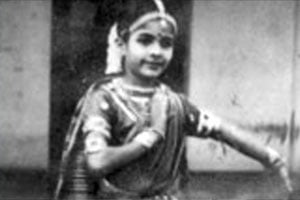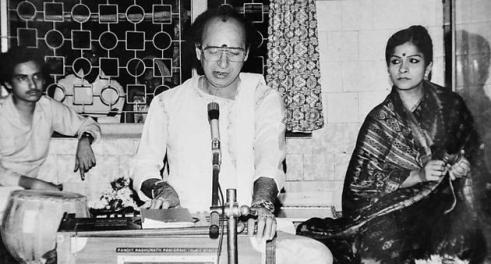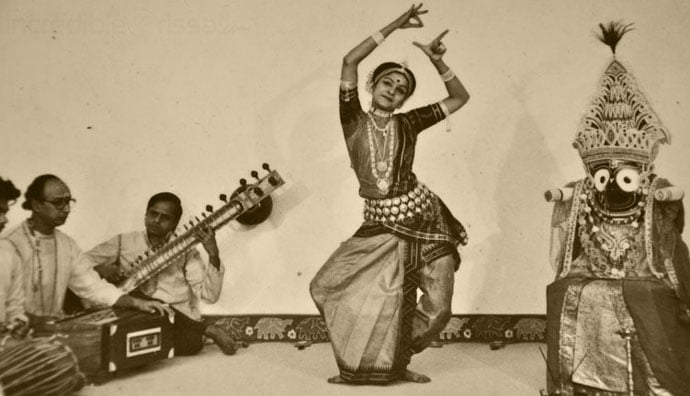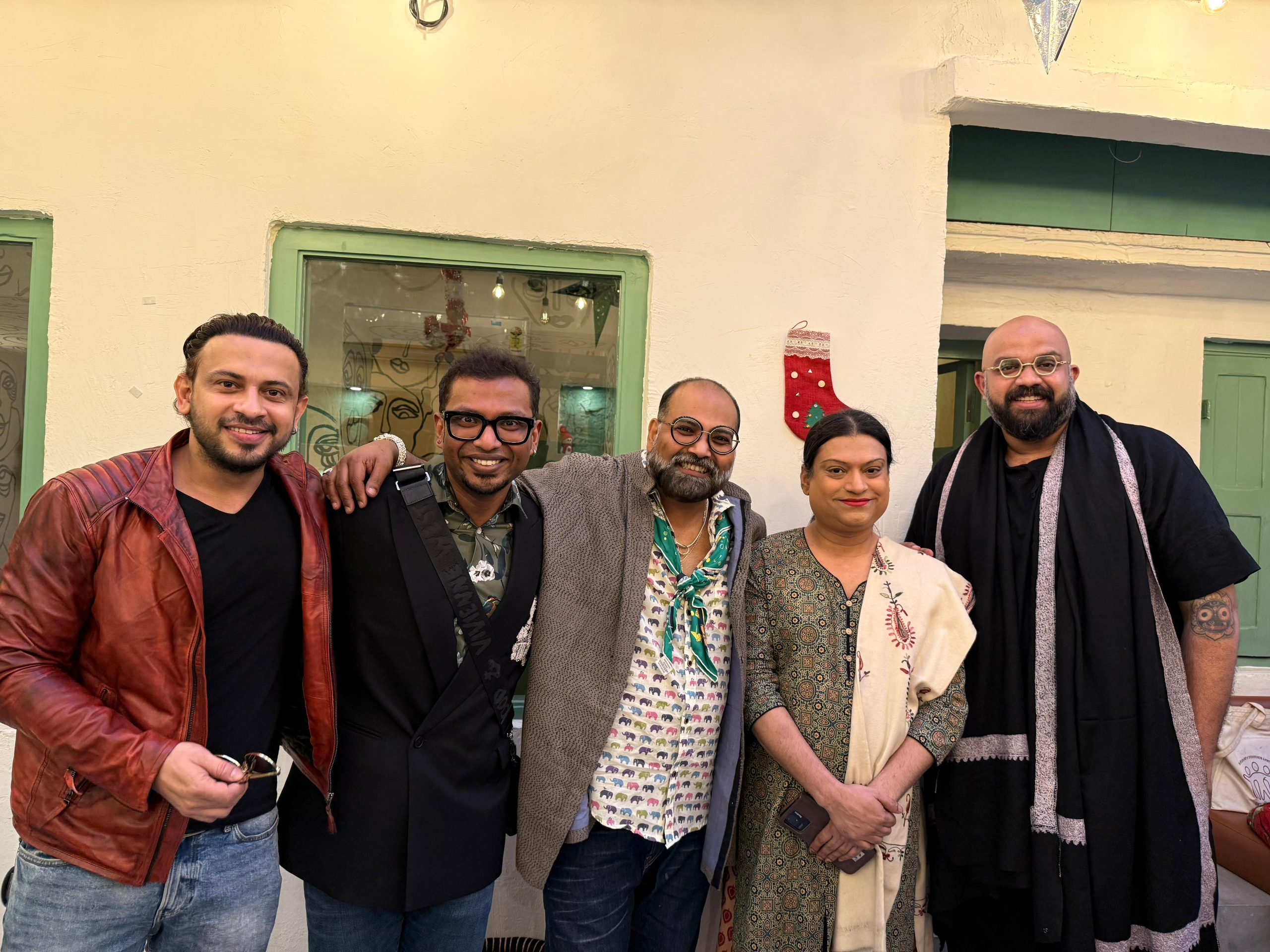Sanjukta Panigrahi was born on 24 August 1944. She was the first Indian woman to embrace Odissi at the age of four. Trained under Odissi maestro Guru Kelucharan Mohapatra, Sanjukta had dance imbibed in her blood. As her biography states, she would dance to the rhythmic beats of activities such as firewood chopping, slicing of vegetables, etc.
Early life
Born to parents Abhiram and Shakuntala Mishra, Sanjukta belonged to a traditional Brahmin family. Though her mother recognized the dancing talent in her daughter and encouraged her, Sanjukta received some resistance from father. The primary cause of Abhiram’s displeasure was that back in those days, dancing was considered to be an undignified act. It was only performed by women who were not allowed dignity, such as Devdasis or Maharis in temples.
As a child artist

Image source: Srjan
She was the student of Guru Kelucharan Mohapatra and thoroughly enjoyed her stage recitals. Sanjukta, at the age of nine, performed at the annual festival of the Children’s Little Cinema in Kolkata. She was considered the best child artist during 1950–1953. But the turning point of her life as a child artist came with her winning the first prize at the International Children’s Film Festival in 1952.
She left for Kalakshetra in Chennai to be tutored under Guru Rukmini Devi Arundale. As she was only nine, this deterred Rukmini Devi to accept her as a disciple, but it was on the insistence of Sanjukta’s mother wherein Rukmini Devi decided to put Sanjukta on a trial for three months. Sanjukta did not disappoint her.
Her devotion to Odissi fuelled her grit and she refused to return to her parents unless she learnt the dance form. This impressed Rukmini devi under whose tutelage Sanjukta learned the dance and also continued her academics from the Senior Cambridge Institute.
Higher education and training
She graduated with a Nrityapraveen diploma in Bharatnatyam with Kathakali as the second subject. She was a part of Kalakshetra Ballet Troupe, which performed both in India and abroad. She stayed in Chennai for six years and trained herself in Odissi, Bharatnatyam and Kathakali and returned to Odisha at the age of fourteen. Though awarded a scholarship by the Odisha Government to learn Kathak from Guru Hazarilal in Mumbai, she left the course midway and returned to Odisha to focus on Odissi.
Marriage
During her stay in Kalakshetra, Nilamani Panigrahi often visited her and was impressed by her talent. He wanted his son Raghunath, who was a popular singer in Chennai, to marry Sanjukta. The proposal was rejected by Abhiram as he feared that both artists cannot make a good living.
By that time, Sanjukta had already fallen in love with Raghunath and married him at the age of sixteen. Subsequently, she bore two sons at the age of seventeen and nineteen. The couple dealt with severe lows in life when Raghunath left his career in Chennai for her.

Sanjukta Panigrahi, Raghunath and their son Sabyasachi. Image source: Odisha Sun Times
They tried their luck in Mumbai but failed. The family returned to Chennai, but success was a far cry as the two-year abstinence from the Chennai music industry made him lose his foothold. The hardships took a toll on Sanjukta’s childhood and youth. The couple returned to Odisha.
Sanjukta Panigrahi took up a job as a dance lecturer in a music college. Raghunath also teamed up with her. He sang during her dance recitals and as an added supplement to finance their family, he administered the national music orchestra. Thereafter, there was no looking back. Sanjukta performed in India and also in the US, Philippines, UK, Israel, Greece and France.
Also Read: Rasoolan Bai And The Lost Art Of Thumri | #IndianWomenInHistory
Achievements in the field of classical dance
Being a staunch disciple of Guru Kelucharan Mohapatra, Jhelum Paranjape, an Odissi dancer, says Sanjukta would run to the feet of her Guru if she made any mistake in her dance. She was considered one of the greatest disciples of Guruji and both the Guru and disciple performed at various dance festivals.
The Indian classical dance forms comprise Natya, Nritta and Abhinaya. Sanjukta’s talent was in Nritta and she was considered a perfectionist. It is said she was also adept in the other two forms, but not too keen on them. Her dance methodology ranged from traditional numbers from Jayadeva’s Gita Govind, padabalies of Surdas to a sort of jugalbandi between the dancer and the musician in Raga Bageshwari. In the words of noted dance critic, Dr Sunil Kothari, “Sanjukta gave up Bharatnatyam and devoted her life to Odissi, putting her signature on the form”.
Sanjukta Panigrahi was fondly addressed as ‘Sanjunani’ by her disciples. She was an introvert, she had the least interest in saris, jewellery and other mundane things. She was an epitome of patience with her disciples and would cover up for their mistakes to Guru Kelucharan Mohapatra.
Jhelum further stated that “Raghunath was the lifelong vocal accompaniment to her and enhancing her already spiritual dance with his soulful singing. Sanjukta Panigrahi was the perfectionist, the moralist, the memory wizard. Guru Kelucharan Mohapatra was the bundle of energy, the Pandora’s Box, the phenomena in Odissi”. Sanjukta was the first lady to break the taboo on Odissi and perform at the Hanuman temple in Varanasi.
Later life and death
Given to her huge contribution to the field of Odissi classical dance, Sanjukta Panigrahi was awarded the Padma Shri and the Sangeet Natak Academy Award in 1975 and 1976 respectively. She lost the battle to cancer on 24 June 1997 at the age of fifty-two.
Sanjukta, with never-ending effort, uplifted Odissi to new heights when the dance was almost forgotten. Guru Kelucharan Mohapatra was deeply saddened by the demise of his favourite disciple. She had many disciples both in India and abroad who mourned her loss. Post her demise, in the year 1999, her husband Raghunath formed the Sanjukta Memorial Trust, which provides scholarships to those with promising potential in Odissi.
Also Read: Sitara Devi: Introducing Bollywood To Kathak | #IndianWomenInHistory
Featured Image Credit: Incredible Orissa
About the author(s)
Rimli Bhattacharya works in the corporate sector. She is also a trained Indian Classical Dancer in Kathak and Odissi. Rimli has been awarded a Star Blogger by team Bonobology for her essay “Running a solo Marathon”.




